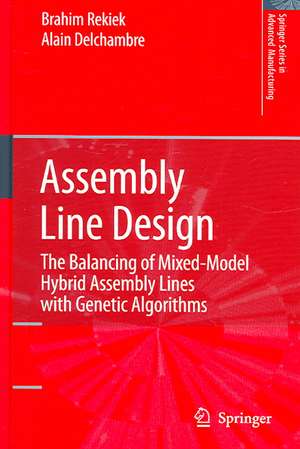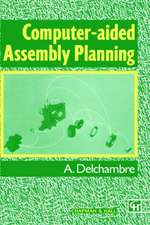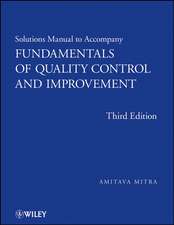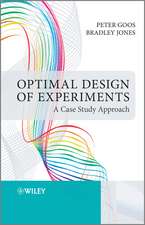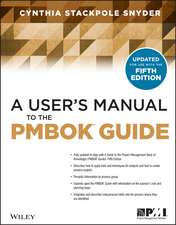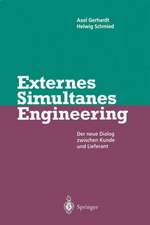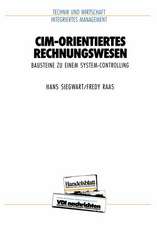Assembly Line Design: The Balancing of Mixed-Model Hybrid Assembly Lines with Genetic Algorithms: Springer Series in Advanced Manufacturing
Autor Brahim Rekiek, Alain Delchambreen Limba Engleză Hardback – 10 noi 2005
It is important to give the designer tools to help him meet the different objectives. 3 techniques based on the Grouping Genetic Algorithm are presented which can be used to aid assembly line design:
- ‘equal piles for assembly lines’ deals with assembly line balancing (balancing stations’ loads);
- a method based on a multiple objective grouping genetic algorithm (MO-GGA) deals with resource planning (selection of equipment);
- ‘balance for operation’, deals with the changes during the operation of assembly lines.
This book will interest technical personnel in design, planning and production departments in industry as well as managers in industry. It will also be of use to researchers and postgraduates in mechanical, manufacturing or micro-engineering.
| Toate formatele și edițiile | Preț | Express |
|---|---|---|
| Paperback (1) | 634.68 lei 6-8 săpt. | |
| SPRINGER LONDON – 28 oct 2010 | 634.68 lei 6-8 săpt. | |
| Hardback (1) | 639.59 lei 6-8 săpt. | |
| SPRINGER LONDON – 10 noi 2005 | 639.59 lei 6-8 săpt. |
Din seria Springer Series in Advanced Manufacturing
- 18%
 Preț: 1124.92 lei
Preț: 1124.92 lei - 18%
 Preț: 952.89 lei
Preț: 952.89 lei - 18%
 Preț: 1122.56 lei
Preț: 1122.56 lei - 17%
 Preț: 463.35 lei
Preț: 463.35 lei - 18%
 Preț: 1231.95 lei
Preț: 1231.95 lei - 15%
 Preț: 671.14 lei
Preț: 671.14 lei - 20%
 Preț: 691.51 lei
Preț: 691.51 lei - 18%
 Preț: 956.81 lei
Preț: 956.81 lei - 15%
 Preț: 632.37 lei
Preț: 632.37 lei - 20%
 Preț: 655.85 lei
Preț: 655.85 lei - 15%
 Preț: 636.94 lei
Preț: 636.94 lei - 18%
 Preț: 949.06 lei
Preț: 949.06 lei - 18%
 Preț: 1830.17 lei
Preț: 1830.17 lei - 19%
 Preț: 562.16 lei
Preț: 562.16 lei - 18%
 Preț: 1821.63 lei
Preț: 1821.63 lei - 18%
 Preț: 945.79 lei
Preț: 945.79 lei - 18%
 Preț: 949.10 lei
Preț: 949.10 lei - 18%
 Preț: 1552.01 lei
Preț: 1552.01 lei - 18%
 Preț: 1383.81 lei
Preț: 1383.81 lei - 18%
 Preț: 958.38 lei
Preț: 958.38 lei - 15%
 Preț: 639.25 lei
Preț: 639.25 lei - 18%
 Preț: 952.72 lei
Preț: 952.72 lei - 18%
 Preț: 945.79 lei
Preț: 945.79 lei - 15%
 Preț: 647.27 lei
Preț: 647.27 lei - 18%
 Preț: 945.92 lei
Preț: 945.92 lei - 18%
 Preț: 1215.99 lei
Preț: 1215.99 lei - 18%
 Preț: 1226.73 lei
Preț: 1226.73 lei - 18%
 Preț: 1840.43 lei
Preț: 1840.43 lei - 18%
 Preț: 1225.13 lei
Preț: 1225.13 lei - 18%
 Preț: 952.72 lei
Preț: 952.72 lei - 15%
 Preț: 634.68 lei
Preț: 634.68 lei - 15%
 Preț: 641.53 lei
Preț: 641.53 lei - 18%
 Preț: 947.35 lei
Preț: 947.35 lei - 18%
 Preț: 954.45 lei
Preț: 954.45 lei - 18%
 Preț: 951.77 lei
Preț: 951.77 lei - 15%
 Preț: 634.68 lei
Preț: 634.68 lei - 15%
 Preț: 636.94 lei
Preț: 636.94 lei - 18%
 Preț: 945.14 lei
Preț: 945.14 lei - 15%
 Preț: 638.89 lei
Preț: 638.89 lei - 18%
 Preț: 958.73 lei
Preț: 958.73 lei - 18%
 Preț: 1104.88 lei
Preț: 1104.88 lei - 18%
 Preț: 1226.73 lei
Preț: 1226.73 lei
Preț: 639.59 lei
Preț vechi: 752.45 lei
-15% Nou
Puncte Express: 959
Preț estimativ în valută:
122.42€ • 133.02$ • 102.90£
122.42€ • 133.02$ • 102.90£
Carte tipărită la comandă
Livrare economică 21 aprilie-05 mai
Preluare comenzi: 021 569.72.76
Specificații
ISBN-13: 9781846281129
ISBN-10: 1846281121
Pagini: 180
Ilustrații: XVIII, 160 p. 95 illus.
Dimensiuni: 155 x 235 x 15 mm
Greutate: 0.4 kg
Ediția:2006
Editura: SPRINGER LONDON
Colecția Springer
Seria Springer Series in Advanced Manufacturing
Locul publicării:London, United Kingdom
ISBN-10: 1846281121
Pagini: 180
Ilustrații: XVIII, 160 p. 95 illus.
Dimensiuni: 155 x 235 x 15 mm
Greutate: 0.4 kg
Ediția:2006
Editura: SPRINGER LONDON
Colecția Springer
Seria Springer Series in Advanced Manufacturing
Locul publicării:London, United Kingdom
Public țintă
ResearchCuprins
Assembly Line Design Problems.- Designing Assembly Lines.- Design Approaches.- Assembly Line: History and Formulation.- Evolutionary Combinatorial Optimisation.- Evolutionary Combinatorial Optimisation.- Multiple Objective Grouping Genetic Algorithm.- Assembly Line Layout.- Equal Piles for Assembly Line Balancing.- The Resource Planning for Assembly Line.- Balance for Operation.- The Integrated Method.- Evolving to Integrate Logical and Physical Layout of Assembly Lines.- Concurrent Approach to Design Assembly Lines.- A Real-world Example Optimised by the OptiLine Software.- Conclusions and Future Work.
Recenzii
The design of efficient assembly lines is a problem of considerable industrial importance and contributions in this domain are always appreciated. This book aims to develop new and generic assembly line tools which are capable of evolving a wide range of different line designs with minimal reconfiguration by a designer. In particular, it presents new techniques to deal with assembly line balancing and resource planning.
The book is well written and documented. It is a good reference for postgraduate students and practitioners who are working in the field of resource management and scheduling in manufacturing systems.
International Journal of Advanced Manufacturing Technology
Reviewer: A A Afify, MEC, Cardiff University
The book is well written and documented. It is a good reference for postgraduate students and practitioners who are working in the field of resource management and scheduling in manufacturing systems.
International Journal of Advanced Manufacturing Technology
Reviewer: A A Afify, MEC, Cardiff University
Notă biografică
Rekiek Brahim received a license in Physics from the Univetsité Abdel Malek Essaadi, Tetouan and the D.E.S in production and robotics at the Université Libre de Bruxelles (U.L.B.), Brussels in 1994 and 1996, respectively. He received his Ph.D. degree in Artificial Intelligence in 2000 from the Université Libre de Bruxelles. Much of his work was carried out in collaboration with industrial companies. From 2001 to 2002, he worked as a member of the Sales Marketing Service at Fabricom Airports Systems, Brussels, Belgium. Since 2002, he has been working as a member of the Projects Management team. He has been an analyst and project manager responsible for the development of the baggage handling systems of many airports. His interests include software architecture, systems design, concurrent engineering, and artificial intelligence.
Alain Delchambre obtained his Master and Phd degrees in Mechanical Engineering from the University of Brussels (ULB) in 1983 and 1990 respectively. After three years in industry, he joined a research centre for the Belgian Metalworking Industry (CRIF/WTCM). Since 1994, he has been a Professor at the Faculty of Applied Sciences in ULB and is head of the CADCAM department. He has published three books and more than 80 papers in the areas of concurrent engineering, computer aided design and genetic algorithms.
Alain Delchambre obtained his Master and Phd degrees in Mechanical Engineering from the University of Brussels (ULB) in 1983 and 1990 respectively. After three years in industry, he joined a research centre for the Belgian Metalworking Industry (CRIF/WTCM). Since 1994, he has been a Professor at the Faculty of Applied Sciences in ULB and is head of the CADCAM department. He has published three books and more than 80 papers in the areas of concurrent engineering, computer aided design and genetic algorithms.
Textul de pe ultima copertă
Efficient assembly line design is a problem of considerable industrial importance. Unfortunately, like many other design processes, it can be time-consuming and repetitive. In addition to this, assembly line design is often complex owing to the number of multiple components involved: line efficiency, cost, reliability and space for example. The main objective is to integrate the design with operations issues, thereby minimising its costs.
Since it is impossible to replace a designer’s intelligence, experience and creativity, it is important to provide him with a set of assistance tools in order to meet the conflicting objectives involved. Assembly Line Design presents three techniques based on the Grouping Genetic Algorithm (a powerful and broadly applicable optimisation and stochastic search technique) which can be used to aid efficient assembly line design:
• ‘equal piles for assembly lines’, a new algorithm introduced to deal with assembly line balancing (balancing stations’ loads);
• a new method based on a multiple objective grouping genetic algorithm (MO-GGA) aiming to deal with resource planning (selection of equipment to carry out assembly tasks);
‘• balance for operation’ (BFO), introduced to deal with the changes during the operation phase of assembly lines.
Assembly Line Design will be of interest to technical personnel working in design, planning and production departments in industry as well as managers in industry who want to learn more about concurrent engineering. This book will also be of value to researchers and postgraduate students in mechanical, manufacturing or micro-engineering.
The Springer Series in Advanced Manufacturing publishes the best teaching and reference material to support students, educators and practitioners in manufacturing technology and management. This international series includesadvanced textbooks, research monographs, edited works and conference proceedings covering all subjects in advanced manufacturing. The series focuses on new topics of interest, new treatments of more traditional areas and coverage of the applications of information and communication technology (ICT) in manufacturing.
Since it is impossible to replace a designer’s intelligence, experience and creativity, it is important to provide him with a set of assistance tools in order to meet the conflicting objectives involved. Assembly Line Design presents three techniques based on the Grouping Genetic Algorithm (a powerful and broadly applicable optimisation and stochastic search technique) which can be used to aid efficient assembly line design:
• ‘equal piles for assembly lines’, a new algorithm introduced to deal with assembly line balancing (balancing stations’ loads);
• a new method based on a multiple objective grouping genetic algorithm (MO-GGA) aiming to deal with resource planning (selection of equipment to carry out assembly tasks);
‘• balance for operation’ (BFO), introduced to deal with the changes during the operation phase of assembly lines.
Assembly Line Design will be of interest to technical personnel working in design, planning and production departments in industry as well as managers in industry who want to learn more about concurrent engineering. This book will also be of value to researchers and postgraduate students in mechanical, manufacturing or micro-engineering.
The Springer Series in Advanced Manufacturing publishes the best teaching and reference material to support students, educators and practitioners in manufacturing technology and management. This international series includesadvanced textbooks, research monographs, edited works and conference proceedings covering all subjects in advanced manufacturing. The series focuses on new topics of interest, new treatments of more traditional areas and coverage of the applications of information and communication technology (ICT) in manufacturing.
Caracteristici
Presents techniques based on the Grouping Genetic Algorithm which can be used to aid efficient assembly line design Includes supplementary material: sn.pub/extras
